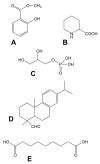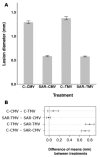Signals of Systemic Immunity in Plants: Progress and Open Questions
- PMID: 29642641
- PMCID: PMC5979450
- DOI: 10.3390/ijms19041146
Signals of Systemic Immunity in Plants: Progress and Open Questions
Abstract
Systemic acquired resistance (SAR) is a defence mechanism that induces protection against a wide range of pathogens in distant, pathogen-free parts of plants after a primary inoculation. Multiple mobile compounds were identified as putative SAR signals or important factors for influencing movement of SAR signalling elements in Arabidopsis and tobacco. These include compounds with very different chemical structures like lipid transfer protein DIR1 (DEFECTIVE IN INDUCED RESISTANCE1), methyl salicylate (MeSA), dehydroabietinal (DA), azelaic acid (AzA), glycerol-3-phosphate dependent factor (G3P) and the lysine catabolite pipecolic acid (Pip). Genetic studies with different SAR-deficient mutants and silenced lines support the idea that some of these compounds (MeSA, DIR1 and G3P) are activated only when SAR is induced in darkness. In addition, although AzA doubled in phloem exudate of tobacco mosaic virus (TMV) infected tobacco leaves, external AzA treatment could not induce resistance neither to viral nor bacterial pathogens, independent of light conditions. Besides light intensity and timing of light exposition after primary inoculation, spectral distribution of light could also influence the SAR induction capacity. Recent data indicated that TMV and CMV (cucumber mosaic virus) infection in tobacco, like bacteria in Arabidopsis, caused massive accumulation of Pip. Treatment of tobacco leaves with Pip in the light, caused a drastic and significant local and systemic decrease in lesion size of TMV infection. Moreover, two very recent papers, added in proof, demonstrated the role of FMO1 (FLAVIN-DEPENDENT-MONOOXYGENASE1) in conversion of Pip to N-hydroxypipecolic acid (NHP). NHP systemically accumulates after microbial attack and acts as a potent inducer of plant immunity to bacterial and oomycete pathogens in Arabidopsis. These results argue for the pivotal role of Pip and NHP as an important signal compound of SAR response in different plants against different pathogens.
Keywords: Arabidopsis; N-hydroxypipecolic acid; SAR signalling; azelaic acid; glycerol-3-phosphate; light dependent signalling; methyl salicylate; pipecolic acid; salicylic acid; spectral distribution of light; tobacco.
Conflict of interest statement
The authors declare no conflict of interest. The founding sponsors had no role in the design of the study; in the collection, analyses, or interpretation of data; in the writing of the manuscript, and in the decision to publish the results.
Figures






Similar articles
-
Flavin Monooxygenase-Generated N-Hydroxypipecolic Acid Is a Critical Element of Plant Systemic Immunity.Cell. 2018 Apr 5;173(2):456-469.e16. doi: 10.1016/j.cell.2018.02.049. Epub 2018 Mar 22. Cell. 2018. PMID: 29576453
-
Long-distance communication and signal amplification in systemic acquired resistance.Front Plant Sci. 2013 Feb 22;4:30. doi: 10.3389/fpls.2013.00030. eCollection 2013. Front Plant Sci. 2013. PMID: 23440336 Free PMC article.
-
Signals in systemic acquired resistance of plants against microbial pathogens.Mol Biol Rep. 2021 Apr;48(4):3747-3759. doi: 10.1007/s11033-021-06344-7. Epub 2021 Apr 24. Mol Biol Rep. 2021. PMID: 33893927 Review.
-
The mobile SAR signal N-hydroxypipecolic acid induces NPR1-dependent transcriptional reprogramming and immune priming.Plant Physiol. 2021 Jul 6;186(3):1679-1705. doi: 10.1093/plphys/kiab166. Plant Physiol. 2021. PMID: 33871649 Free PMC article.
-
l-lysine metabolism to N-hydroxypipecolic acid: an integral immune-activating pathway in plants.Plant J. 2018 Oct;96(1):5-21. doi: 10.1111/tpj.14037. Epub 2018 Sep 1. Plant J. 2018. PMID: 30035374 Review.
Cited by
-
Red and Blue Light Induce Soybean Resistance to Soybean Mosaic Virus Infection through the Coordination of Salicylic Acid and Jasmonic Acid Defense Pathways.Viruses. 2023 Dec 7;15(12):2389. doi: 10.3390/v15122389. Viruses. 2023. PMID: 38140630 Free PMC article.
-
Modulation of Plant Defense System in Response to Microbial Interactions.Front Microbiol. 2020 Jul 3;11:1298. doi: 10.3389/fmicb.2020.01298. eCollection 2020. Front Microbiol. 2020. PMID: 32719660 Free PMC article. Review.
-
Seed Transmission of Pathogens: Non-Canonical Immune Response in Arabidopsis Germinating Seeds Compared to Early Seedlings against the Necrotrophic Fungus Alternaria brassicicola.Plants (Basel). 2022 Jun 28;11(13):1708. doi: 10.3390/plants11131708. Plants (Basel). 2022. PMID: 35807659 Free PMC article.
-
Threat at One End of the Plant: What Travels to Inform the Other Parts?Int J Mol Sci. 2021 Mar 19;22(6):3152. doi: 10.3390/ijms22063152. Int J Mol Sci. 2021. PMID: 33808792 Free PMC article. Review.
-
Quick Decline and Stem Pitting Citrus tristeza virus Isolates Induce a Distinct Metabolomic Profile and Antioxidant Enzyme Activity in the Phloem Sap of Two Citrus Species.Plants (Basel). 2023 Mar 21;12(6):1394. doi: 10.3390/plants12061394. Plants (Basel). 2023. PMID: 36987082 Free PMC article.
References
Publication types
MeSH terms
LinkOut - more resources
Full Text Sources
Other Literature Sources
Molecular Biology Databases
Miscellaneous

